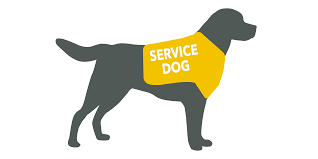Talking points for being around a service dog or answering questions that students or staff might have.
- DO speak to the owner/handler rather than the dog.
The service dog and her handler are a team. If you want to talk to them, always speak to the person first rather than automatically approaching the dog. Remember, the animal is working, and her human’s life could depend on her staying focused on her job.
- DON’T touch the dog without asking permission first.
Touching or petting a working dog is a distraction and may prevent him from tending to his human partner. The dog may be in the process of completing a command or direction given by his human, and you don’t want to interfere.
Fortunately, most service dogs are trained to stay in work mode until they receive a release command from their handler. That’s why many service dogs are able to ignore outside influences.
- DO treat the owner/handler with sensitivity and respect
Asking a service dog’s handler personal questions about his or her disability is out of bounds. It’s disrespectful and an intrusion of privacy. As a teacher, you are not allowed to share the student’s name or the reason the student may have a service dog.
Assume the service dog team can handle things themselves. If you sense they could use your help, ask first. And don’t take it personally if your offer is rejected, as there’s usually a good reason.
- DON’T offer food to a service dog
Food is the ultimate distraction for the working dog and can jeopardize the working team. Not only are food and treats a potential distraction, but many service dogs are fed a specific diet and often on a specific schedule.
- DON’T assume a napping service dog is off duty
All dogs nap, including working dogs. When her handler is sitting or standing for some length of time, it’s perfectly natural and appropriate for a service dog to catch a few winks. She’s still technically at work, however, so all dos and don’ts remain in effect.
- DO inform the handler if a service dog approaches you
If a working dog approaches you, sniffs or nudges you, etc., politely let the handler know. Resist the urge to respond to the dog — the handler will correct the dog.
- DON’T assume service dogs never get to ‘just be dogs’.
When the dog is wearing a vest then the dog is working.
